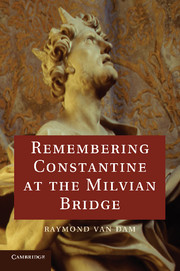Book contents
- Frontmatter
- Contents
- PREFACE
- ABBREVIATIONS
- TIMELINE
- Constantines Empire After 312
- 1 FOREWORD: VISIONS OF CONSTANTINE
- 2 THE AFTERLIFE OF CONSTANTINE
- 3 ECCLESIASTICAL HISTORIES
- 4 CONSTANTINE'S MEMORIES
- 5 EUSEBIUS' COMMENTARY
- 6 SHAPING MEMORIES IN THE WEST
- 7 ROME AFTER THE BATTLE
- 8 BACKWARD AND FORWARD
- 9 REMEMBERING MAXENTIUS
- 10 BACK WORD: THE BRIDGE
- EDITIONS AND TRANSLATIONS
- BIBLIOGRAPHY
- INDEX
3 - ECCLESIASTICAL HISTORIES
Published online by Cambridge University Press: 03 May 2011
- Frontmatter
- Contents
- PREFACE
- ABBREVIATIONS
- TIMELINE
- Constantines Empire After 312
- 1 FOREWORD: VISIONS OF CONSTANTINE
- 2 THE AFTERLIFE OF CONSTANTINE
- 3 ECCLESIASTICAL HISTORIES
- 4 CONSTANTINE'S MEMORIES
- 5 EUSEBIUS' COMMENTARY
- 6 SHAPING MEMORIES IN THE WEST
- 7 ROME AFTER THE BATTLE
- 8 BACKWARD AND FORWARD
- 9 REMEMBERING MAXENTIUS
- 10 BACK WORD: THE BRIDGE
- EDITIONS AND TRANSLATIONS
- BIBLIOGRAPHY
- INDEX
Summary
Only two generations after his death, memories of the historical Constantine were fading. According to a preacher at Antioch in 387, “he founded many great cities and he conquered many barbarians. We remember none of them.” Historians nevertheless continued to read and write about Constantine, either directly as an earlier emperor or indirectly as an influential paradigm. As a social process this shaping of the emperor's legacy was entangled with some of the important trends of late antiquity, including the impact of Constantinople as an eastern capital during the fourth century, the establishment of barbarian kingdoms in the West during the fifth century, and the attempted reconquest of the West by the eastern emperor Justinian during the sixth century.
Thinking about Constantine provided a common denominator for Christians, who usually appreciated him, and for pagans, who typically resented him. For both Christians and pagans Constantine remained meaningful. They could share a discourse even as they disagreed about his significance. As a result, both Christians and pagans, both supporters and critics, became, wittingly or not, ecclesiastical historians. Evaluating episodes from Constantine's reign offered an opportunity to assess the place of Christianity in late antique society.
PAGAN CRITICS
At the beginning of the sixth century Zosimus composed a history of the Roman empire that covered the period from the uncertainty over imperial succession in the early third century to the coming of the barbarians in the early fifth century.
- Type
- Chapter
- Information
- Remembering Constantine at the Milvian Bridge , pp. 33 - 55Publisher: Cambridge University PressPrint publication year: 2011

